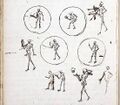Phantasmagoria (nonfiction): Difference between revisions
No edit summary |
|||
| Line 15: | Line 15: | ||
== Fiction cross-reference == | == Fiction cross-reference == | ||
* [[ | * [[Crimes against light]] | ||
* [[Gnomon algorithm]] | |||
* [[Gnomon Chronicles]] | |||
== Nonfiction cross-reference == | == Nonfiction cross-reference == | ||
* [[Electrotachyscope (nonfiction)]] | |||
* [[Flip book (nonfiction)]] | |||
* [[History of animation (nonfiction)]] | |||
* [[History of film (nonfiction)]] | |||
* [[Philip James de Loutherbourg (nonfiction)]] - Inventor of the Eidophusikona, a mechanical theater | * [[Philip James de Loutherbourg (nonfiction)]] - Inventor of the Eidophusikona, a mechanical theater | ||
* [[Light (nonfiction)]] | * [[Light (nonfiction)]] | ||
* [[Eadweard Muybridge (nonfiction)]] | |||
* [[Optical toys (nonfiction)]] | |||
* [[Phenakistiscope (nonfiction)]] - a spinning cardboard disc attached vertically to a handle which creates a fluid illusion of motion. | |||
* [[Praxinoscope (nonfiction)]] | |||
* [[Precursors of film (nonfiction)]] | |||
* [[Jacob Philadelphia (nonfiction)]] | * [[Jacob Philadelphia (nonfiction)]] | ||
* [[Strobe light (nonfiction)]] | |||
* [[Thaumatrope (nonfiction)]] | |||
* [[Théâtre Optique (nonfiction)]] - an animated moving picture system invented by Émile Reynaud and patented in 1888. | |||
* [[Zoetrope (nonfiction)]] | |||
* [[Zoopraxiscope (nonfiction)]] | |||
External links: | External links: | ||
Revision as of 08:01, 13 January 2019
Phantasmagoria (fantasmagorie, fantasmagoria) was a form of horror theater that (among other techniques) used one or more magic lanterns to project frightening images such as skeletons, demons, and ghosts onto walls, smoke, or semi-transparent screens, typically using rear projection to keep the lantern out of sight.
Mobile or portable projectors were used, allowing the projected image to move and change size on the screen, and multiple projecting devices allowed for quick switching of different images. In many shows the use of spooky decoration, total darkness, sound effects, (auto-)suggestive verbal presentation and sound effects were also key elements.
Some shows added all kinds of sensory stimulation, including smells and electric shocks. Even required fasting, fatigue (late shows) and drugs have been mentioned as methods of making sure spectators would be more convinced of what they saw.
The shows started under the guise of actual séances in Germany in the late 18th century, and gained popularity through most of Europe (especially England) throughout the 19th century.
In the News
Fiction cross-reference
Nonfiction cross-reference
- Electrotachyscope (nonfiction)
- Flip book (nonfiction)
- History of animation (nonfiction)
- History of film (nonfiction)
- Philip James de Loutherbourg (nonfiction) - Inventor of the Eidophusikona, a mechanical theater
- Light (nonfiction)
- Eadweard Muybridge (nonfiction)
- Optical toys (nonfiction)
- Phenakistiscope (nonfiction) - a spinning cardboard disc attached vertically to a handle which creates a fluid illusion of motion.
- Praxinoscope (nonfiction)
- Precursors of film (nonfiction)
- Jacob Philadelphia (nonfiction)
- Strobe light (nonfiction)
- Thaumatrope (nonfiction)
- Théâtre Optique (nonfiction) - an animated moving picture system invented by Émile Reynaud and patented in 1888.
- Zoetrope (nonfiction)
- Zoopraxiscope (nonfiction)
External links:
- Phantasmagoria @ Wikipedia

